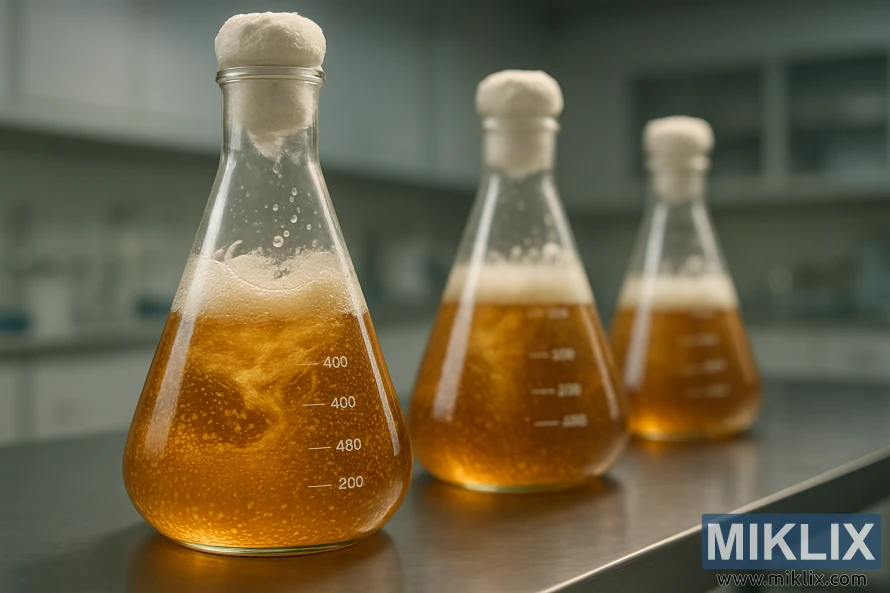Image: Yeast Fermentation in Laboratory Flasks
Published: July 29, 2025 at 7:35:23 AM UTC
Last updated: September 27, 2025 at 9:14:02 PM UTC
Close-up of Erlenmeyer flasks with active fermenting liquid, highlighting precise yeast pitching in a controlled lab environment.
This image offers a compelling glimpse into the controlled and methodical world of fermentation science, where precision and biological vitality intersect in a laboratory setting. The focal point of the scene is a trio of Erlenmeyer flasks, each filled with a frothy, amber-hued liquid that swirls with visible energy. The flasks are arranged neatly on a reflective stainless steel bench, their conical shapes and graduated markings evoking the rigor of scientific experimentation. The liquid inside is clearly undergoing active fermentation—tiny bubbles rise in steady streams, breaking the surface with soft pops and forming a delicate foam that clings to the inner walls of the glass. This effervescence is not merely aesthetic; it is the signature of yeast metabolism in motion, a visual cue that sugars are being converted into alcohol and carbon dioxide.
Each flask is sealed with a cotton plug, a classic method used in microbiological labs to allow gas exchange while preventing contamination. The plugs sit snugly in the necks of the flasks, their fibrous texture contrasting with the smooth glass and the dynamic liquid within. These seals suggest that the contents are being closely monitored, perhaps as part of a comparative study of yeast strains or fermentation conditions. The presence of volume markings—from 100 mL to 500 mL—adds another layer of precision, indicating that the process is being quantified and controlled at every stage.
The lighting in the room is soft and diffused, casting a gentle glow across the bench and the flasks. It highlights the sheen of the stainless steel, the translucence of the liquid, and the subtle textures of foam and cotton. Shadows fall lightly, creating depth without distraction, and the overall ambiance is one of quiet focus. The background, though slightly blurred, reveals a clean, modern laboratory environment—cabinets, equipment, and surfaces that speak to sterility and order. This setting reinforces the idea that fermentation, while rooted in ancient tradition, is also a subject of contemporary scientific inquiry.
What makes this image particularly striking is its ability to convey both the complexity and the elegance of yeast pitching. This stage of brewing, where yeast is introduced to the wort, is critical to the outcome of the final product. The rate at which yeast is pitched, its health and viability, and the conditions under which it is activated all influence the flavor, aroma, and clarity of the beer. The image captures this moment with reverence, portraying it not as a routine step but as a pivotal act of transformation. The swirling liquid, the rising bubbles, the careful containment—all suggest a process that is alive, responsive, and deeply dependent on human understanding and intervention.
The tone of the image is clinical yet warm, a balance that reflects the dual nature of brewing as both science and craft. It invites the viewer to appreciate the beauty of fermentation at its most elemental, to see the artistry in the foam and the precision in the measurements. It is a portrait of care and curiosity, of a process that begins with observation and ends with creation. Through its composition, lighting, and subject matter, the image elevates the humble Erlenmeyer flask into a vessel of possibility, where biology meets intention and the future of flavor is quietly taking shape.
The image is related to: Fermenting Beer with Fermentis SafAle S-33 Yeast

